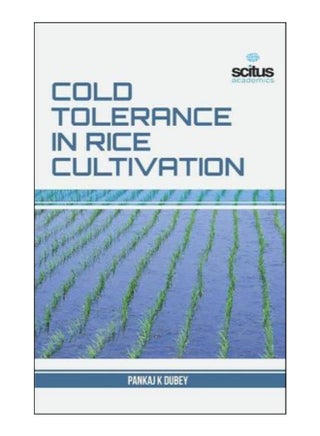| وصف الكتاب | As a cereal grain, it is the most widely consumed staple food for a large part of the worlds human population, especially in Asia. Thus, investigating the effect of low temperatures is important. The effect of low temperature on rice production are diverse and complex. Since a large portion of maize crops are grown for purposes other than human consumption, rice is the most important grain with regard to human nutrition and caloric intake, providing more than one fifth of the calories consumed worldwide by humans. The plant has many different variations, but is generally a short living plant, with an average life span of 3-7 months, depending on the climate and the variety. It is not a water plant but substantial amounts of water are required for the planting. Cultivated species of rice are considered to be semi-aquatic annuals. The height of the plant can range from 0.4m to over 5m in some floating rices. Rice is cultivated in many different ways around the world, the different methods used can differ greatly even in the same locality. Methods of growing differ greatly in different localities, but in most Asian countries the traditional hand methods of cultivating and harvesting rice are still practiced. The fields are prepared by plowing, fertilizing, and smoothing. The seedlings are started in seedling beds and, after 30 to 50 days, are transplanted by hand to the fields, which have been flooded by rain or river water. During the growing season, irrigation is maintained by *-controlled canals or by hand watering. The fields are allowed to drain before cutting. In the United States and in many parts of Europe, rice cultivation has undergone the same mechanization at all stages of cultivation and harvesting as have other grain crops. This book provides a clear understanding of cold stress in rice in the hopes that it will provide insight to the subject for further research so that rice plants may be grown efficiently in cold regions with high productivity. As a cereal grain, it is the most widely consumed staple food for a large part of the worlds human population, especially in Asia. Thus, investigating the effect of low temperatures is important. The effect of low temperature on rice production are diverse and complex. Since a large portion of maize crops are grown for purposes other than human consumption, rice is the most important grain with regard to human nutrition and caloric intake, providing more than one fifth of the calories consumed worldwide by humans. The plant has many different variations, but is generally a short living plant, with an average life span of 3-7 months, depending on the climate and the variety. It is not a water plant but substantial amounts of water are required for the planting. Cultivated species of rice are considered to be semi-aquatic annuals. The height of the plant can range from 0.4m to over 5m in some floating rices. Rice is cultivated in many different ways around the world, the different methods used can differ greatly even in the same locality. Methods of growing differ greatly in different localities, but in most Asian countries the traditional hand methods of cultivating and harvesting rice are still practiced. The fields are prepared by plowing, fertilizing, and smoothing. The seedlings are started in seedling beds and, after 30 to 50 days, are transplanted by hand to the fields, which have been flooded by rain or river water. During the growing season, irrigation is maintained by *-controlled canals or by hand watering. The fields are allowed to drain before cutting. In the United States and in many parts of Europe, rice cultivation has undergone the same mechanization at all stages of cultivation and harvesting as have other grain crops. This book provides a clear understanding of cold stress in rice in the hopes that it will provide insight to the subject for further research so that rice plants may be grown efficiently in cold regions with high productivity. |
استرجاع مجاني وسهل
أفضل العروض

